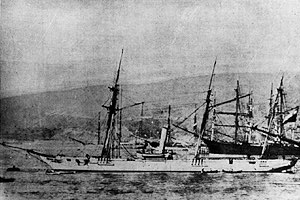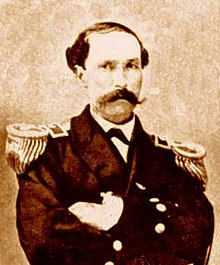
Huáscar is an ironclad turret ship owned by the Chilean Navy built in 1865 for the Peruvian government. It is named after the 16th-century Inca emperor, Huáscar. She was the flagship of the Peruvian Navy and participated in the Battle of Pacocha and the War of the Pacific of 1879–1883. At the Battle of Angamos, Huáscar, captained by renowned Peruvian naval officer Miguel Grau Seminario, was captured by the Chilean fleet and commissioned into the Chilean Navy.

The Battle of Angamos was a naval encounter of the War of the Pacific fought between the navies of Chile and Perú at Punta Angamos, on 8 October 1879. The battle was the culminating point of a naval campaign that lasted about five months in which the Chilean Navy had the sole mission of eliminating its Peruvian counterpart. In the struggle, two armored frigates, led by Commodore Galvarino Riveros Cárdenas and Navy Captain Juan José Latorre battered and later captured the Peruvian monitor Huáscar, under Rear Admiral Miguel Grau Seminario.

Agustín Arturo Prat Chacón was a Chilean lawyer and navy officer. He was killed in the Battle of Iquique, during the War of the Pacific.

The Battle of Punta Gruesa was a naval action that took place on May 21, 1879, during the War of the Pacific between Chile and Peru. This may be labelled as the second part of the Naval Battle of Iquique, although it is described in many sources as a separate battle.

Juan José Latorre Benavente Chilean Vice Admiral, one of the principal actors of the War of the Pacific, and hero of the Battle of Angamos.

The schooner Virgen de Covadonga, was a schooner built in Spain and launched in 1859. During the Spanish-South American War (1863-1866), it was captured by Chilean forces at the end of the Papudo naval action and incorporated into the Chilean Navy. After being assigned to exploration missions, she was later assigned to the Chilean squadron that participated in the Pacific War (1879-1883). In the Battle of Punta Gruesa defeated the Ironclad Independencia.

Carlos Arnaldo Condell De La Haza was a Chilean naval officer and hero of the Battle of Punta Gruesa during the start of the War of the Pacific.

The Naval campaign of the War of the Pacific or Saltpeter war, was a naval campaign that took place from 1879 to 1884, involving Peru, and Chile, undertaken in order to support land forces in the Atacama Desert. Although the conflict lasted until 1884, the primary naval engagements occurred between 1879 and 1880. Due to the rough terrain and few transport methods it was imperative to have control of the ports in order to have a good supply source in the region. It resulted in a successful campaign by Chile, and the success of their land campaigns eventually led to a Chilean victory, which cut off Bolivia's access to the coast.

The Battle of Iquique was a naval engagement on 21 May 1879, during the War of the Pacific, where a Chilean corvette commanded by Arturo Prat Chacón faced a Peruvian ironclad under Miguel Grau Seminario. The battle occurred off the port of Iquique, Peru, and ended with the sinking of the Chilean wooden corvette Esmeralda by the Peruvian ironclad Huáscar after four hours of combat, marking a victory for Peru.

The Tarapacá campaign was a short stage of the War of the Pacific in the last months of 1879, after the Chileans won definitive naval superiority at Angamos. It took its name from the region where it was fought.

Juan Bravo was a Chilean Navy sailor of Mapuche origin, hero of the naval Battle of Punta Gruesa during the War of the Pacific. Juan Bravo distinguished himself in the Battle of Punta Gruesa where he, while on board the schooner Covadonga, sniped down numerous Peruvians on board the ironclad Independencia.

The Naval Battle of Arica was a naval battle which took place on 27 February 1880 during the Blockade of Arica as part of the War of the Pacific.

Manuel Antonio Villavicencio Freyre was a prominent Peruvian Navy officer, who participated in the War of the Pacific. He also served as a Senator.

BAP Unión was a corvette of the Peruvian Navy, originally ordered by the government of the Confederate States of America during the American Civil War. Built in France it was bought by the Peruvian Navy and during its service participated in the Chincha Islands War and in the War of the Pacific in which it was scuttled following the Blockade of Callao to prevent it falling into Chilean hands.

Aurelio García y García was a Peruvian marine, diplomat and politician. García was a friend and comrade-in-arms of Miguel Grau, Manuel Ferreyros and Lizardo Montero, all of whom were known as the Four Aces of the Peruvian Navy. He was also elected Mayor of Lima in 1877. He was also a man of wide culture, who was fully fluent in the English language and who had scientific inclinations.

The Raids of the Huáscar were a series of raids that occurred by the Peruvian ironclad Huáscar under the command of Miguel Grau Seminario during the War of the Pacific. The actions kept the Chilean government in check for nearly five months which ended after the Battle of Angamos.
The Second Battle of Iquique was a naval battle of the War of the Pacific that occurred on July 10, 1879. During the battle, the Huáscar faced the 2nd Chilean Naval Squadron which was blockading the port which lead to both forces to face each other.

Carlos de los Heros Aguilar (1850-1878) was a Peruvian sailor and war hero of the War of the Pacific. He was known for his death during the Second Battle of Antofagasta and was the only Peruvian death in the battle.

Nicolás Federico Portal was a Peruvian captain and politician during the War of the Pacific. He is known for being the captain of the BAP Unión throughout the war.

The Rupture of the Blockade of Arica was a naval battle of the War of the Pacific during the Blockade of Arica. The rupture was carried out by Manuel Villavicencio who commanded the BAP Unión of the Peruvian Navy. The Unión broke the Chilean blockade of the port twice in less than 8 hours on March 17, 1880.



















